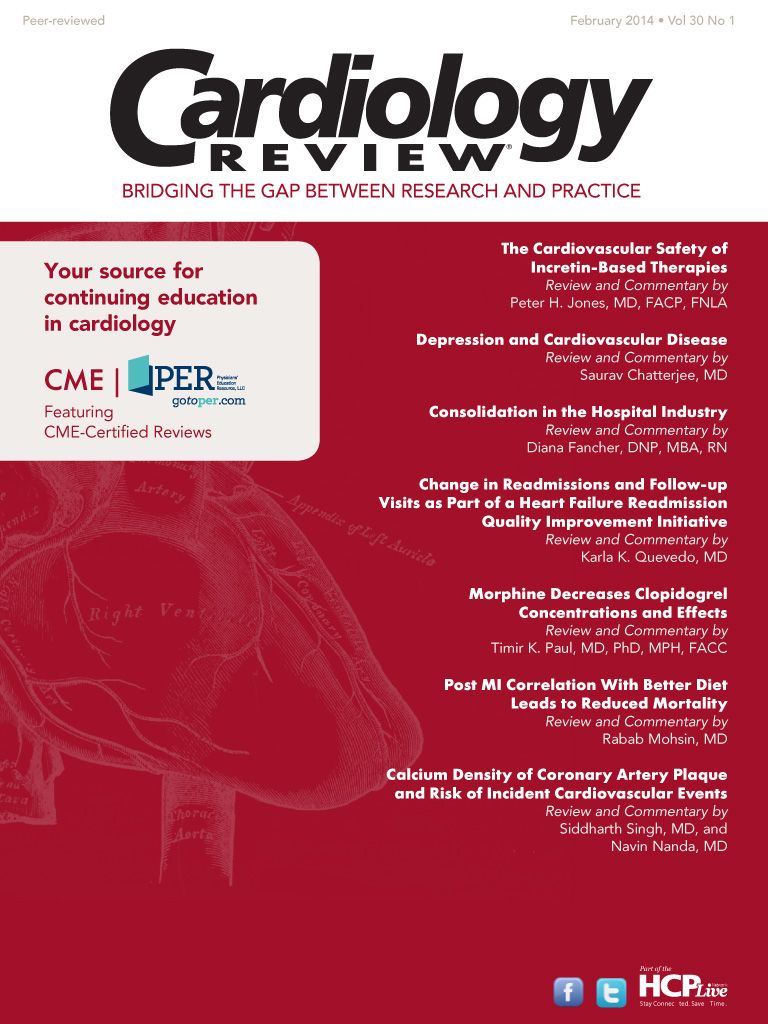Publication
Article
Cardiology Review® Online
The Cardiovascular Safety of Incretin-Based Therapies
Author(s):
A review of the cardiovascular safety and potential benefits of incretin-based therapies for patients with type 2 diabetes mellitus.

Peter H. Jones, MD, FACP, FNLA
Review
Petrie JR. The cardiovascular safety of incretin-based therapies: a review of the evidence. Cardiovasc Diabet. 2013;12:130. doi:10.1186/1475-2840-12-130.

Type 2 diabetes mellitus (T2DM) has many deleterious effects on cellular and organ function, resulting in a high incidence of renal disease, neuropathy, and vascular events (coronary heart disease, stroke, and peripheral artery disease). Improving glucose levels does reduce the incidence of some microvascular complications but has had limited efficiency in reducing cardiovascular (CV) event rates. When previously unknown CV risks were raised with rosiglitazone,1,2 the FDA responded with guidelines for assessing the CV risk and safety for all future glucose-lowering drug development programs. The incretin-based treatments for diabetes [glucagon-like peptide-1 (GLP-1) receptor agonists and dipeptidyl peptidase-4 (DPP-4) inhibitors] are subject to these guidelines, which are reviewed in terms of CV safety by Dr Petrie.
Study Details
The author of this review chose recent publications and abstracts from a literature search that he felt were relevant to the topic. This included articles that described the potential benefits of incretin-based treatments on CV risk factors (weight, blood pressure, fasting and postprandial lipid levels, and surrogate biomarkers), and on heart rate, QT interval, and ischemia-reperfusion injury. Most importantly, the review includes clinical trials that report the incidence of major adverse CV events with incretin therapies, which are conveniently listed in a table within the article. Finally, CV outcomes trials with 2 DPP-4 inhibitors (saxagliptin and alogliptin) were completed in 2013, just prior to the publication of this review, and are referenced but not discussed in depth.
The main conclusion of this review is that there are plausible CV benefits of incretin-based therapies for T2DM, and, thus far, there are no signs of CV harm.
CommentaryA Well-Referenced Discussion of CV Safety
The American Diabetes Association (ADA) Standards of Medical Care recommend metformin as the initial drug treatment for newly diagnosed T2DM, with the exception of considering initial insulin therapy for symptomatic, marked glucose and/or glycated hemoglobin (A1C) elevations.³ After 3 months of lifestyle change plus metformin, if the A1C is not at the patient’s individualized target, then the addition of an oral agent (sulfonylurea, thiazolinedione, or DPP-4) or GLP-1 agonist or insulin can be considered. The choice of the second agent added to metformin should be individualized, based on the potential efficacy, hypoglycemia risk, effect on body weight, and cost. The long-term benefits of glucose control in T2DM favor a reduction in microvascular complications, with less evidence for benefit on the risk of vascular events such as stroke and myocardial infarction (MI). After the FDA approved the thiazolinedione drugs (rosiglitazone and pioglitazone), their excellent efficacy led to widespread clinical acceptance despite the known side effects of fluid retention and weight gain. Later, data from clinical trials questioned the cardiovascular safety of rosiglitazone specifically, which resulted in the restriction of its use by the FDA in 2010 and by the European regulatory agency, as well as a black-box warning for heart failure risk added to the pioglitazone package insert. Just this past year, a meta-analysis from the DIABAMON project, presented at the 2013 ADA Scientific Sessions, confirmed the higher risk of heart failure and MI with rosiglitazone, while showing a modest trend to benefit in reducing MI risk with pioglitazone, and a significant CV risk reduction with metformin.4
The FDA responded to the rosiglitazone data with a new guidance in 2008 that requires evaluation of the risk ratio for major adverse CV events for all new diabetes drugs. The guidance requires that pre-approval clinical trials demonstrate a risk ratio upper boundary of 1.8 for the 2-sided 95% confidence interval (CI) for major CV events versus control, and that subsequent trials have a risk ratio less than 1.3.5 The manuscript review of the incretin-based therapies highlighted by Petrie provides a well-referenced discussion of the CV safety of both the GLP-1 and DPP-4 drug classes to date.
When the Petrie manuscript went to press, 2 cardiovascular outcomes trials, 1 with saxagliptin (SAVOR-TIMI 53) and 1 with alogliptin (EXAMINE), had been published but were not discussed in depth. In more detail, the SAVOR trial enrolled 16,492 T2DM patients with high CV risk and randomized to receive saxagliptin versus placebo for a median follow-up of 2.1 years.6 The primary end point of CV death, MI, or ischemic stroke occurred in 7.3% of saxagliptin patients versus 7.2% of placebo patients. The secondary composite end point was also not different between the 2 groups; however, there were more saxagliptin patients hospitalized for heart failure (a subgroup of the composite) [3.5% vs 2.8%; hazard ratio (HR), 1.27 (1.07-1.51)]. There also was no difference in the incidence of pancreatitis between the groups. The EXAMINE trial enrolled 5380 TD2M patients with either an MI or unstable angina event within the prior 15 to 90 days to receive alogliptin or placebo for a median 18 months.7 The study design was a pre-specified noninferiority of 1.3 in the HR for the primary end point of CV death, nonfatal MI, and nonfatal stroke. The primary end point occurred in 11.3% of alogliptin patients versus 11.8% of placebo patients (HR, 0.96; upper boundary, 1.16), thus meeting the non-inferiority design. There was no signal for heart failure with alogliptin, and no risk of pancreatitis. While these 2 trials did not demonstrate any reduction in CV events during their short duration, more importantly, they did not reveal any CV safety signals, except for the heart failure hospitalization subgroup of the secondary composite end point with saxagliptin. The ongoing trials with the other DPP-4 drugs, linagliptin (CAROLINA and CARMELINA) and sitagliptin (TECOS), will add more data about safety, and possibly clarify if there is any heart failure risk with this class.
The GLP-1 receptor agonists exanatide and liraglutide appear to have no CV safety concerns from data thus far, which, in contrast to the thiazolinediones, shows no evidence of fluid retention and good evidence for weight loss. No long-term CV outcomes trials have been completed with this class (although the trials are in progress, most notable being liraglutide in LEADER and exanatide in EXSCEL), and more data should be collected concerning the possible risk for pancreatitis, pancreatic adenomas, and/or thyroid medullary tumors.8
If we return to the clinician’s choice for managing glucose in TD2M according to the ADA standards of care, the question is, what agent should be added to metformin if the A1C is not at a patient’s individualized target? Of course, each choice has a pro and con profile. The incretin-based therapies may be more expensive than other options but they have a low risk for hypoglycemia, do not cause weight gain, and, based on the available data thus far, are not associated with adverse CV risks.
 
References
JAMA
1. Singh S, Loke YK, Furberg CD. Long-term risk of cardiovascular events with rosiglitazone: a meta-analysis. . 2007;298:1189-1195.
JAMA.
2. Graham DJ, Ouellet-Hellstrom R, MaCurdy TE, et al. Risk of acute myocardial infarction, stroke, heart failure and death in elderly Medicare patients treated with rosiglitazone and pioglitazone. 2010;304:411-418.
Diabetes Care.
3. American Diabetes Association Standards of Care in Diabetes — 2014. 2014;37(suppl 1):S14-S80.
4. Boyle P, Boniol M, Koechlin A, et al. Safety of glucose-lowering medications: the Diabetes Adverse Event Monitor (DIABAMON) project: Cardiovascular disease. American Diabetes Association 2013 Scientific Sessions, October 31-November 3, 2013, New Orleans, LA. [Abstract 1405-P.]
N Engl J Med
5. Hiatt WR, Kaul S, Smith RJ. The cardiovascular safety of diabetes drugs: insights from the rosiglitazone experience. . 2013. doi: 10.1056/NEJMp1309610.
N Engl J Med
6. The SAVOR-TIMI 53 Steering Committee and Investigators: saxagliptin and cardiovascular outcomes in patients with type 2 diabetes mellitus. . 2013;369:1317-1326.
N Engl J Med.
7. The EXAMINE Investigators. Alogliptin after acute coronary syndrome in patients with type 2 diabetes. 2013;369:1327-1335.
JAMA Intern Med.
8. Gier B, Butler PC. Glucagon-like peptide-1 based drugs and pancreatitis: clarity at last but what about pancreatic cancer? 2013;173:539-540.
About the Author
P
eter
H. J
ones
, MD, FACP, FNLA,
is an Associate Professor in the Center for Cardiovascular Disease Prevention at Baylor College of Medicine, Methodist DeBakey Heart and Vascular Center, Houston, TX.






